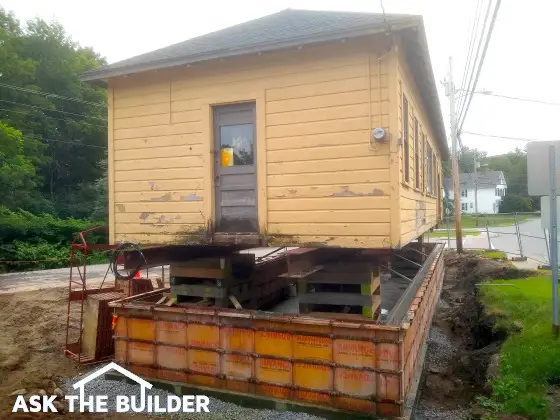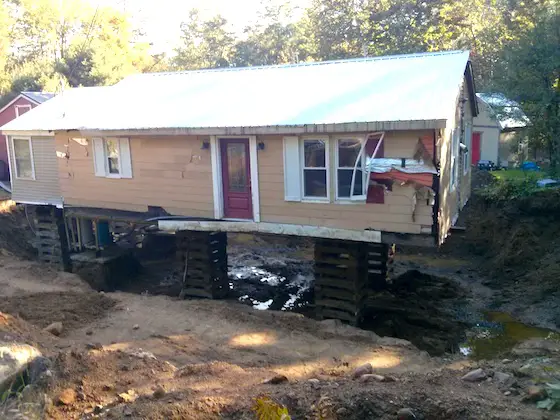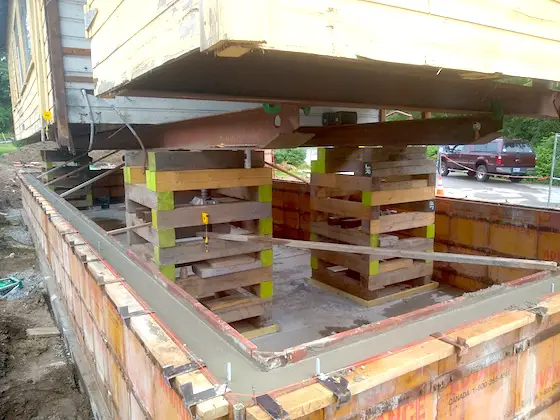Install A New Concrete Foundation

Install a New Concrete Foundation | This house was temporarily lifted up about 8 feet in the air allowing a new concrete foundation to be poured. A new dry crawlspace is in the owner’s future. Copyright 2021 Tim Carter
Install a New Concrete Foundation - Going Up!
Recently my daughter purchased an old camp summer house on a lake. The house is about eighty years old and was built on crude cinder blocks that just rested on stony soil. Frost heave over the years has caused the doors and windows to not fit well. Otherwise, the house, because it was built using old-growth timber, is in remarkable shape.
She wondered, “Dad, can a house like this be salvaged? Can a new poured concrete foundation be poured under it? Can a full basement be put under the house? Will the doors and windows work well again? How’s that accomplished?” These are all great questions and the answers vary depending on where the house is located and what lies just inches below the soil.
New Concrete Foundation in Meredith, NH
Just months before she made this new real estate investment, I saw in my own town in central New Hampshire an owner do the same thing. Based on what I witnessed, the house was about the same age as my daughter’s. It’s possible the house in my town was well over 100 years old based on its location and proximity to the town center and railroad tracks. The style and frame construction of the two houses were almost identical.
If you’ve never seen a house moved before, you might think it’s impossible to install a new concrete foundation under an existing house. Not only is it possible, but it’s probably more common than you might think. This process happens out of sight and often on back roads that you might not travel.
New Concrete Foundation in Sanbornton, NH
Two years ago, another house near me got a new concrete foundation. The house movers had to dig pits in the existing crawlspace to place their cribbing. You can tell they did this looking just to the left and down of the white window to the left of the red front door in the photo below. It's not easy to see because it's in the shadows but you can see the old concrete slab the water heaters used to sit on. Look at how the slab is 4 feet in the air now. It's amazing what house movers can do.

This house on Lower Bay Road in Sanbornton, NH looks to be in bad shape, but it's now got a new lease on life. With that metal roof and its soon-to-be new foundation, it can last another 100 years.
Who Installs a New Concrete Foundation on an Existing Home?
The companies that specialize in constructing a new foundation under an existing house are house movers. The process of lifting a house up to move it is the first step in building a new foundation. If the house is not moving off the lot, it’s just a matter of lifting it up high enough so the foundation crew can work comfortably and safely. This often means the house might be lifted 6, 8, or 10 feet in the air.
Do You Need Cribbing?
Yes, you need cribbing to support the house. Each moving company might tackle the job differently. The first step I’ve witnessed is the placement of four or more, concrete footing pads under the house where cribbing will be placed. Cribbing is comprised of giant square 6x6 pieces of oak timbers typically about 42 inches long. Two pieces are placed parallel with one another on the smooth and level concrete and then two more pieces are placed at a 90-degree angle on top of the ends of the first two. This process is repeated until the house is lifted to the desired height.

This is an excellent photo of the cribbing used to support a house while the new concrete foundation is being constructed. Note the steel I-beams that support the house and then rest on the cribbing. The giant jacks are hidden inside the cribbing.
The top of these concrete footings is normally placed at the future top of the concrete slab that will be poured in the new crawlspace or basement. It’s critical these footings are at the same height and perfectly level. This makes it easy to place the cribbing with a minimum of shimming.
How Many I-beams are Required?
Two, or more, steel I-beams are then slid under the house and centered on the cribbing. Giant house-lifting jacks are placed inside the cribbing. The jack pistons are centered under the I-beams. The professionals start to lift the house making sure to keep it as level as possible. As it goes up in the air, more cribbing is stacked to support the house.
Once the house is high enough in the air, the foundation crews start to work. If the soil is deep enough, they can dig it out using small machinery that can get under the house. Skilled operators are required so they don’t touch the cribbing.
Will Bedrock Limit the Crawlspace Height?
If bedrock is close to the surface, it may not be possible to place a tall crawlspace or full basement under the house. The house movers in the area almost always know the soil conditions and can manage this expectation before they start to work. You can also dig test pits around the outside of the house to determine the depth of bedrock prior to the house movers showing up.
It doesn’t matter if the house was built square as the foundation crews use plumb bobs and other tools to ensure the new foundation will match the exact shape of the outer walls of the house that’s suspended above them.
How are the I-beams Removed?
The foundation crews have to install U-shaped notches at the top of at least one wall of the new foundation. These notches are aligned with the steel I-beams that the house floor joists are resting on. Once the new foundation is complete and the house can be lowered onto the new poured concrete foundation, the I-beams need to be pulled out from under the house through these notches.
The notches can then be filled in with concrete blocks or new windows might be placed in these locations. Discuss your options with the house-moving company.
Don’t forget to install excellent foundation waterproofing and drain tile on the outside of the new foundation. It’s also wise to consider radon collection piping. This needs to be placed under the new slab below the house. Consult one, or more, of the radon maps that can be found with ease on the Internet to see if radon is an issue in your area.
Related Column:
Column 1435
3 Responses to Install A New Concrete Foundation